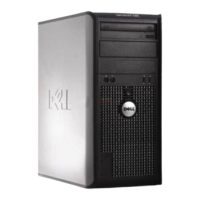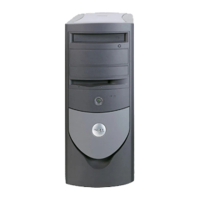290 Solving Problems
www.dell.com | support.dell.com
Mouse Problems
CAUTION: Before you begin any of the procedures in this section, follow the safety instructions
located in the Product Information Guide.
IF YOU EXPERIENCE OTHER MEMORY PROBLEMS —
•
Reseat the memory modules
to ensure that your computer is successfully communicating with the
memory.
• Ensure that you are following the memory installation guidelines.
•Run the
Dell Diagnostics
.
CHECK THE MOUSE CABLE —
1
Check the cable connector for bent or broken pins and for damaged or frayed cables. Straighten bent pins.
2
Remove mouse extension cables, if used, and connect the mouse directly to the computer.
3
Shut down the computer, reconnect the mouse cable as shown in the
Quick Reference Guide
for your
computer, and then restart the computer.
RESTART THE COMPUTER —
1
Simultaneously press <Ctrl><Esc> to display the
Start
menu.
2
Type
u
, press the keyboard arrow keys to highlight
Shut down
or
Turn Off
, and then press <Enter>.
3
After the computer turns off, reconnect the mouse cable as shown on the in the
Quick Reference Guide
for
your computer.
4
Start the computer.
TEST THE MOUSE — Connect a properly working mouse to the computer, and try using the mouse. If the
new mouse works, the original mouse is faulty.
CHECK THE MOUSE SETTINGS —
1
Click the
Start
button, click
Control Panel
, and then click
Printers and Other Hardware
.
2
Click
Mouse
.
3
Try adjusting the settings.
If you are using a PS/2 mouse
1 Enter system setup
and ensure that the
Mouse Port
option is set to
On
.
2
Exit system setup and restart the computer.
REINSTALL THE MOUSE DRIVER

